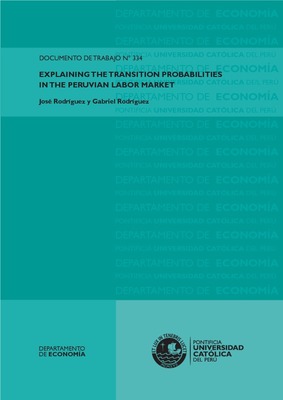| dc.contributor.author | Rodríguez, José | |
| dc.contributor.author | Rodríguez, Gabriel | |
| dc.date.accessioned | 2015-03-19T20:37:53Z | |
| dc.date.available | 2015-03-19T20:37:53Z | |
| dc.date.issued | 2012 | |
| dc.identifier.uri | http://repositorio.pucp.edu.pe/index/handle/123456789/46975 | |
| dc.description.abstract | El estudio tiene 2 objetivos. Primero establecer las principales características de la movilidad laboral; segundo analizar los determinantes de las principales transiciones entre los distintos estados de la ocupación. Para lograr el primer objetivo se utiliza matrices de transición que permiten analizar la dinámica de los mercados laborales y establecer los hechos estilizados de la movilidad laboral. Con relación al segundo objetivo, se ha modelado la pérdida de la ocupación utilizando regresiones logit de manera de poder identificar la importancia tanto de factores de demanda como de oferta. Para esto se utilizan muestras panel de las encuestas de hogares del período 2007-2010. Los resultados indican que existe un importante grado de movilidad entre los distintos estados, pero a nivel agregado estos movimientos tienden a cancelarse, con lo cual la distribución de la población a lo largo del tiempo en esos estados permanece constante. Con relación a la pérdida de ocupación, se ha logrado capturar el importante rol que cumplen las condiciones demanda. | es_ES |
| dc.description.abstract | This study has two aims. First, to establish the main features of labor mobility; and second, to analyze the determinants of the main transitions between states of occupation. In order to achieve the first objective, we utilize transition matrices, on the basis of which different indicators are calculated that allow the characterization of the dynamics of labor markets in Peru. These calculations, in addition to the results of previous works, enable us to establish a number of stylized facts about labor mobility. Regarding the second objective, and having identified the loss of occupation as one of the most important transitions, an analysis of logit regression is performed in order to establish the correlation between supply and demand factors and the probability of staying occupied or losing that status. Panel samples of household surveys on a national scale for the period 2007-2010 are employed. The results indicate that there is an important degree of mobility where important proportions of the population switch between states, but in aggregate these transitions tend to cancel out. With respect to the determinants of the transition, the important role of labor demand has been identified; it was captured with levels in employment and their changes in time. | en_US |
| dc.language.iso | spa | es_ES |
| dc.publisher | Pontificia Universidad Católica del Perú. Departamento de Economía | es_ES |
| dc.relation.ispartof | urn:issn:2079-8466 | |
| dc.relation.ispartof | urn:issn:2079-8474 | |
| dc.relation.ispartofseries | Documento de Trabajo;334 | es_ES |
| dc.rights | info:eu-repo/semantics/openAccess | es_ES |
| dc.rights.uri | http://creativecommons.org/licenses/by-nc-nd/2.5/pe/ | * |
| dc.subject | Trabajo--Perú | es_ES |
| dc.subject | Empleos--Perú | es_ES |
| dc.title | Explaining the Transition Probabilities in the Peruvian Labor Market | es_ES |
| dc.title.alternative | Explicando las Probabilidades de Transición en el Mercado Laboral Peruano | es_ES |
| dc.type | info:eu-repo/semantics/workingPaper | |
| dc.type.other | Documento de trabajo | |
| dc.subject.ocde | http://purl.org/pe-repo/ocde/ford#5.02.00 | |
| dc.publisher.country | PE | |
| renati.advisor.orcid | https://orcid.org/0000-0002-1740-6037 | |
| renati.advisor.orcid | https://orcid.org/0000-0003-1174-964 | |


